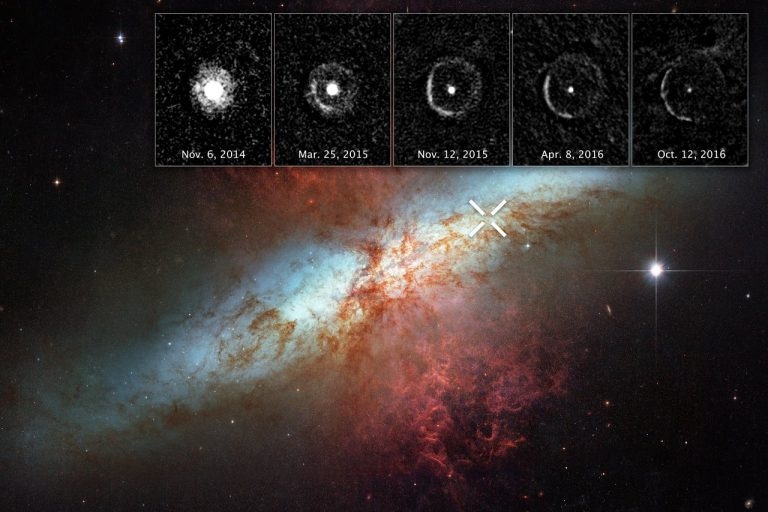Nov 5 2019
The thermonuclear explosion of Type Ia supernovae, which are luminous and powerful stellar explosions, can only be understood using theoretical models. Previously, such models were unable to account for the mechanism that initiated the explosion.
 Light from a supernova explosion in the nearby starburst galaxy Messier 82 is reverberating off a huge dust cloud in interstellar space. The supernova, called SN 2014J, occurred at the upper right of Messier 82, and is marked by an “X.” The supernova was discovered on 21 January 2014. The inset images at the top reveal an expanding shell of light from the stellar explosion sweeping through interstellar space, called a “light echo.” The images were taken over 10 months to nearly two years after the violent event. (Image credit: NASA)
Light from a supernova explosion in the nearby starburst galaxy Messier 82 is reverberating off a huge dust cloud in interstellar space. The supernova, called SN 2014J, occurred at the upper right of Messier 82, and is marked by an “X.” The supernova was discovered on 21 January 2014. The inset images at the top reveal an expanding shell of light from the stellar explosion sweeping through interstellar space, called a “light echo.” The images were taken over 10 months to nearly two years after the violent event. (Image credit: NASA)
Of the various stages in this explosion, the main one, which is present almost in all models, is the generation of a supersonic reaction wave known as detonation, which travels faster than the speed of sound and can burn up all of the material of a star before getting scattered into the vacuum of space.
However, the physics behind the mechanisms that generate a detonation in a star has been obscure. Currently, a group of researchers from the University of Connecticut, Texas A&M University, University of Central Florida, Naval Research Laboratory, and Air Force Research Laboratory has proposed a theory that elucidates on the mysterious process of formation of the detonation at the core of these incredible astronomical events.
The study, which was reported in the Science journal on November 1st, 2019, provides vital insights into this physical process not just in stars but also in chemical systems on Earth.
The study was headed by Alexei Poludnenko, UConn School of Engineering and Texas A&M University; together with Jessica Chambers and Kareem Ahmed, the University of Central Florida; Vadim Gamezo, the Naval Research Laboratory; and Brian Taylor, the Air Force Research Laboratory.
For the first time, researchers could illustrate the detonation formation process from a slow subsonic flame with the help of both experiments and numerical simulations performed on some of the largest supercomputers in the United States. Moreover, they successfully used the results to estimate the detonation formation conditions in one of the classical theoretical scenarios of Type Ia supernova explosion.
Type Ia supernovae explosions occur during the burning of oxygen and carbon packed to a density of about 1000 tons per cubic centimeter in the stellar core, in rapid, thermonuclear reactions. Due to the ensuing explosion, a star is disrupted within just few seconds and ejects a majority of its mass to emit an amount of energy equal to the energy released by the star over its whole lifetime.
For a detonation to form, generally, burning must happen within a confined setting with obstacles, walls, or boundaries that can restrict pressure waves that are emitted by burning.
The increase in pressure leads to the formation of shock waves, the strength of which can rise to the point where they can compress the reacting mixture, igniting it and generating a self-sustaining supersonic front. However, stars do not have obstacles or walls, making the detonation formation puzzling.
As part of this study, the researchers proposed an integrated theory of turbulence-induced deflagration-to-detonation that explains the mechanism and conditions for detonation formation both in unconfined chemical and thermonuclear explosions.
The theory proposes that if a reactive mixture, which burns and discharges energy, is taken and stirred up to form vigorous turbulence, the result could be a disastrous instability that would quickly increase pressure in the system, generating strong shocks and forming a detonation. Incredibly, this theory forecasts the conditions for the formation of detonation in Type Ia supernovae.
The researchers could understand the basic attributes of the physical processes that regulate supernovae explosions since thermonuclear combustion waves are analogous to chemical combustion waves on Earth, because they are regulated by the same physical mechanisms.
Due to the similarities, the study outcomes may be applied to different terrestrial combustion systems where detonations can form, for example, conditions such as industrial accidents that involve gaseous explosions, as well as innovative energy conversion and propulsion applications, like detonation-based engines.
The study was supported by NASA (NNH12AT33I), the Air Force Office of Scientific Research (F4FGA06055G001 and FA95501610403), and the Alpha Foundation for the Improvement of Mine Safety and Health (AFC215FO-73). Computing resources were offered by the Department of Defense under the Frontier project award and by the Naval Research Laboratory.